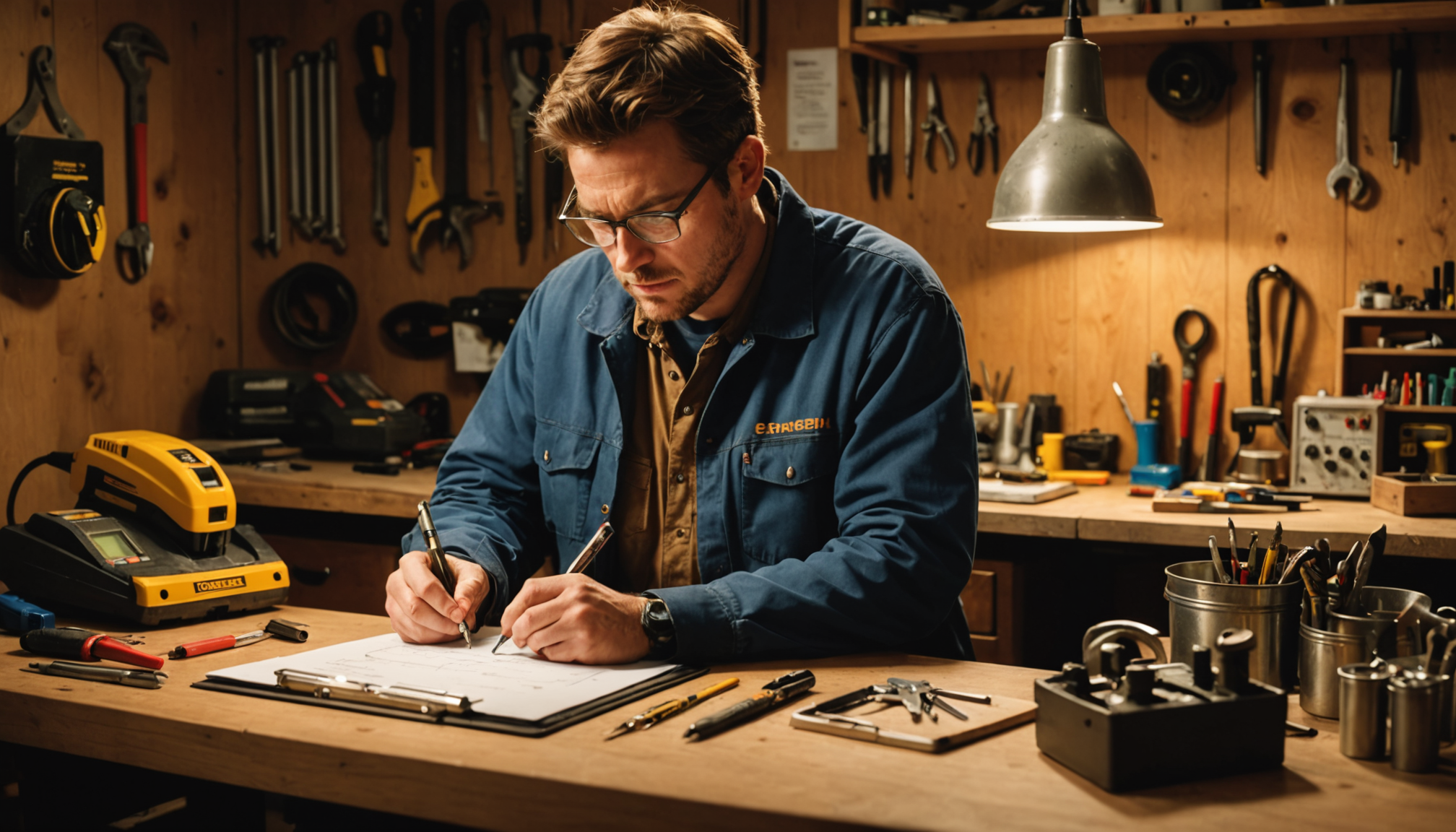Before diving into any home repair task, a thorough assessment of the project is crucial. This initial step not only helps in crafting an effective strategy but also plays a pivotal role in saving both time and money. A well-assessed repair project can make the difference between a successful DIY endeavor and an unnecessarily expensive contractor call.
Start by evaluating the scope of the repair. Understand the complexity and extent of the damage or the task at hand. Is this something that requires a simple patch-up or is a more extensive fix needed? To systematically assess your project, consider the following steps:
- Identify the Problem: Clearly determine what needs fixing. Check for any underlying issues that may not be immediately apparent but could exacerbate the problem if left unaddressed.
- Analyze the Impact: Consider how the issue affects your home. Is it aesthetic, such as peeling paint, or functional, like a leaky faucet? Understanding the impact helps prioritize and determine the urgency of the repair.
- Research Potential Solutions: Look into different methods that can address the problem efficiently. Consult online resources, how-to guides, and forums where DIYers exchange tips and tricks.
- Gather Tools and Resources: List all the tools, materials, and resources needed for the project. Consider what you already own versus what you might need to borrow or purchase.
- Estimate Time and Costs: Create a realistic timeline and budget. Compare the DIY costs with potential professional repair expenses using the table below:
| Task | DIY Cost | Professional Cost |
| Paint a room | $50-$100 | $300-$500 |
| Fix a leaky faucet | $15-$30 | $125-$200 |
| Replace a light fixture | $20-$50 | $150-$300 |
| Patch drywall | $10-$30 | $75-$150 |
The comparison highlights the potential savings when opting for a DIY approach. However, it is essential to weigh these savings against the time commitment and your level of expertise.
Moreover, understanding your own skill level is paramount. If the task is beyond your capabilities, it might lead to further damage, increasing future repair costs. Whenever you’re uncertain, it’s wise to start with a minor task to build confidence before progressing to more complex undertakings.
Investing time upfront in assessing the repair project ensures that you approach it with the right amount of preparation and awareness, ultimately leading to better results and economically sound decisions.
choosing cost-effective materials
When it comes to saving money on repairs, selecting the right materials is critical. Choosing cost-effective materials doesn’t mean sacrificing quality; rather, it involves making informed decisions that balance durability, functionality, and budgetary constraints. Here’s how to go about it:
1. Set a Realistic Budget:
– Start by determining how much you are willing to spend on materials. This will help you focus on options within your price range and avoid overspending. Consider the overall value that the materials will bring versus their cost, weighing factors like longevity and performance.
2. Research Material Options:
– Different materials come with varying price tags and performance levels. Spend some time researching alternatives that suit your needs. For instance:
– Opt for vinyl plank flooring instead of hardwood if cost is a concern. It offers a wood-like appearance but is more affordable and water-resistant.
– Consider engineered stone countertops for the kitchen, which are often cheaper than natural stone but offer similar durability and aesthetic.
3. Prioritize Durable Materials:
– While upfront costs are essential, remember that durable materials tend to save money in the long run by reducing the need for frequent repairs or replacements. Look for:
– Composite siding that mimics the look of wood but resists rot and insect damage.
– High-quality paint that may be pricier initially but offers better coverage and longevity, reducing the need for frequent repainting.
4. Explore Recycled and Reclaimed Materials:
– Consider using salvaged or reclaimed materials, which are not only cost-effective but also environmentally friendly. Places to find these include:
– Local salvage yards or online marketplaces where you can find bricks, wood, or fixtures at a fraction of the cost.
– Non-profit building material stores where recycled goods are available at lower prices.
5. Compare Prices:
– Take the time to compare prices from different suppliers. Online home improvement stores, local retailers, and wholesalers might offer different prices for the same product. Keep an eye out for sales or discounted bulk purchases.
6. Buy in Bulk When Possible:
– For materials that will be used in large quantities and don’t have a short shelf life, buying in bulk can provide significant savings. It’s particularly effective for items like paint, nails, screws, and tiles.
7. Utilize DIY Store Discounts:
– Many home improvement retailers offer loyalty programs or credit cards that provide discounts or cashback on purchases. Signing up can lead to additional savings, especially if you’re undertaking multiple projects.
8. Evaluate Product Reviews:
– Before making a purchase, read reviews and seek recommendations for materials known for balancing quality with affordability. This helps avoid costly mistakes and ensures that the materials meet your expectations in terms of performance and appearance.
By strategically choosing cost-effective materials, not only do you keep expenses in check, but you also ensure that the repairs enhance the value and comfort of your home. Remember, the goal is to find the sweet spot between affordability and quality to achieve satisfactory results without stretching your budget unnecessarily.
tackling common home fixes
When it comes to dealing with those frequent minor issues around the home, knowing how to tackle common home fixes can be incredibly empowering and cost-effective. Homeowners often encounter recurring problems like squeaky doors, dripping faucets, or peeling wallpaper. Addressing these issues on your own not only saves money but also boosts your confidence in handling larger projects down the road.
One of the first tasks you often face is a squeaky door, which can usually be remedied with a simple application of lubricant. A can of spray lubricant or even household items like petroleum jelly can work wonders. Just a few minutes of addressing the squeaky hinges can restore peace to a household, a small but satisfying victory.
Another frequent issue is a dripping faucet, which may seem daunting but often requires minimal effort to fix. Usually, the culprit is a worn washer or O-ring inside the faucet. By turning off the water supply, disassembling the faucet, and replacing the damaged components, you address not just the annoyance but also potential long-term water wastage. Such a fix can significantly reduce your water bill, providing both environmental and economic benefits.
Then there’s peeling wallpaper, a common problem when moisture or time has taken its toll. Tackling this can seem intimidating, but it’s often as simple as applying wallpaper paste and using a smoothing tool to eliminate air bubbles and reattach the paper. By addressing small sections at a time, this task becomes manageable and can refresh a room’s aesthetic without the expense of complete redecoration.
There are also lighting issues, like a flickering bulb, which might be resolved by tightening the bulb or replacing a faulty fixture component. When dealing with electrical fixes, always prioritize safety. Ensure the power is off before troubleshooting and wear appropriate protective gear if necessary.
For those repairs that involve glued items that have come apart, such as furniture joints, using a high-quality wood glue and clamps can restore the integrity of the piece effectively. This not only extends the life of your furniture but also saves the cost of potential replacements.
By focusing on these common fixes, homeowners can maintain the value and functionality of their dwellings without consistently reaching for professional assistance. The key benefits from taking on these tasks yourself include saving money on service fees, learning valuable skills, gaining independence in maintaining your home, and even finding satisfaction in successfully completing each project. With a bit of patience and effort, you can transform how you manage household repairs, making your home a testament to both your handiwork and resourcefulness.
maintaining your tools
Proper maintenance of your tools is key to prolonging their lifespan and enhancing your efficiency in handling repair projects. Well-maintained tools ensure that you’re always ready and equipped to manage any repair task without interruptions, which ultimately helps you save time and money. Here’s how to keep your tools in excellent condition and ready for use:
To start, always clean your tools after each use. Dirt and debris can accumulate, leading to rust and reducing their effectiveness. Use a dry cloth to wipe your tools, removing any moisture and dirt. For tools exposed to more grime, such as gardening tools, a mixture of water and mild detergent can be used to remove stubborn dirt, followed by thorough drying to prevent rust.
Lubrication is crucial for tools with moving parts, such as pliers, wrenches, or power tools. Regularly apply a light machine oil or a silicone spray to keep these parts moving smoothly. This not only prevents rust but also ensures that the tools operate efficiently, reducing wear and tear over time.
Another important tip is to store your tools correctly. Organize them in a dry environment, such as a toolbox, tool chest, or hanging them on a pegboard. Investing in rust inhibitors or silica gel packs to keep moisture at bay can be beneficial, especially in humid climates. If possible, store power tools in their original cases to provide extra protection.
Sharpening your tools, particularly those used for cutting, such as saws, knives, and chisels, is a vital practice. Dull tools not only perform poorly but can also pose safety hazards. Use a proper sharpening tool or service and ensure you follow the correct angle for each specific tool type.
Battery maintenance for cordless tools is also essential. To maximize battery life, charge them correctly and avoid overcharging. Store batteries in a cool, dry place and use them at least every few months to maintain their capacity. Having a maintenance schedule for battery checks can prevent unexpected downtimes during projects.
Inspections can prevent many common tool issues before they develop into larger problems. Regularly inspect for signs of damage, wear, or rust. Tighten loose screws and replace any parts as needed. Look out for power cords that are fraying or damaged, and address these issues promptly to avoid potential safety hazards.
By adopting these maintenance strategies, you not only extend the life of your tools but also maintain their performance and safety. The initial time and effort invested in caring for your tools will pay off through reduced costs on replacements and repairs. Remember, well-maintained tools make for efficient work, ensuring that every repair project you undertake is both smooth and successful.
knowing when to call a professional
When deciding whether a repair project is suitable for a DIY approach or if it demands the expertise of a professional, several factors need consideration. First and foremost, assess the complexity and potential risks associated with the task. Jobs involving electricity or structural changes often warrant professional intervention to ensure safety and compliance with building codes. An understanding of your own skill level and experience is crucial; while minor repairs can boost personal confidence, overestimating your abilities on complex projects can lead to costly mistakes.
Another key consideration is the cost versus benefit analysis. Although DIY might initially seem like the cheaper option, the cost of tools and materials, combined with the potential for error, can sometimes make hiring a professional more economical in the long run. Additionally, time is a significant factor. Busy schedules might leave little room for lengthy projects, especially if unforeseen complications arise, potentially stretching a simple repair into days or weeks.
Consider warranties and guarantees that come with professional services. If a repair doesn’t hold up, a professional can return to correct it without additional cost, whereas a DIY mishap might require a redo at personal expense.
If you find yourself hesitating or uncertain at any step, consulting or hiring a professional to at least guide the process can be beneficial. Their expertise not only ensures the quality of the job but also provides peace of mind knowing the task was correctly executed the first time. Balancing ambition with practicality often leads to the most rewarding and fiscally responsible outcomes when handling home repairs.
In conclusion, tackling home repairs on your own can be an empowering and money-saving adventure when approached with thorough planning and sensible judgment. By assessing projects accurately, opting for cost-effective materials, and maintaining your tools, you can manage many fixes independently. However, recognizing the limits of your capabilities and the complexity of certain tasks will guide you in deciding when professional intervention is the wiser course. Ultimately, this balanced approach to home maintenance will lead to a well-kept home and prudent financial management.


